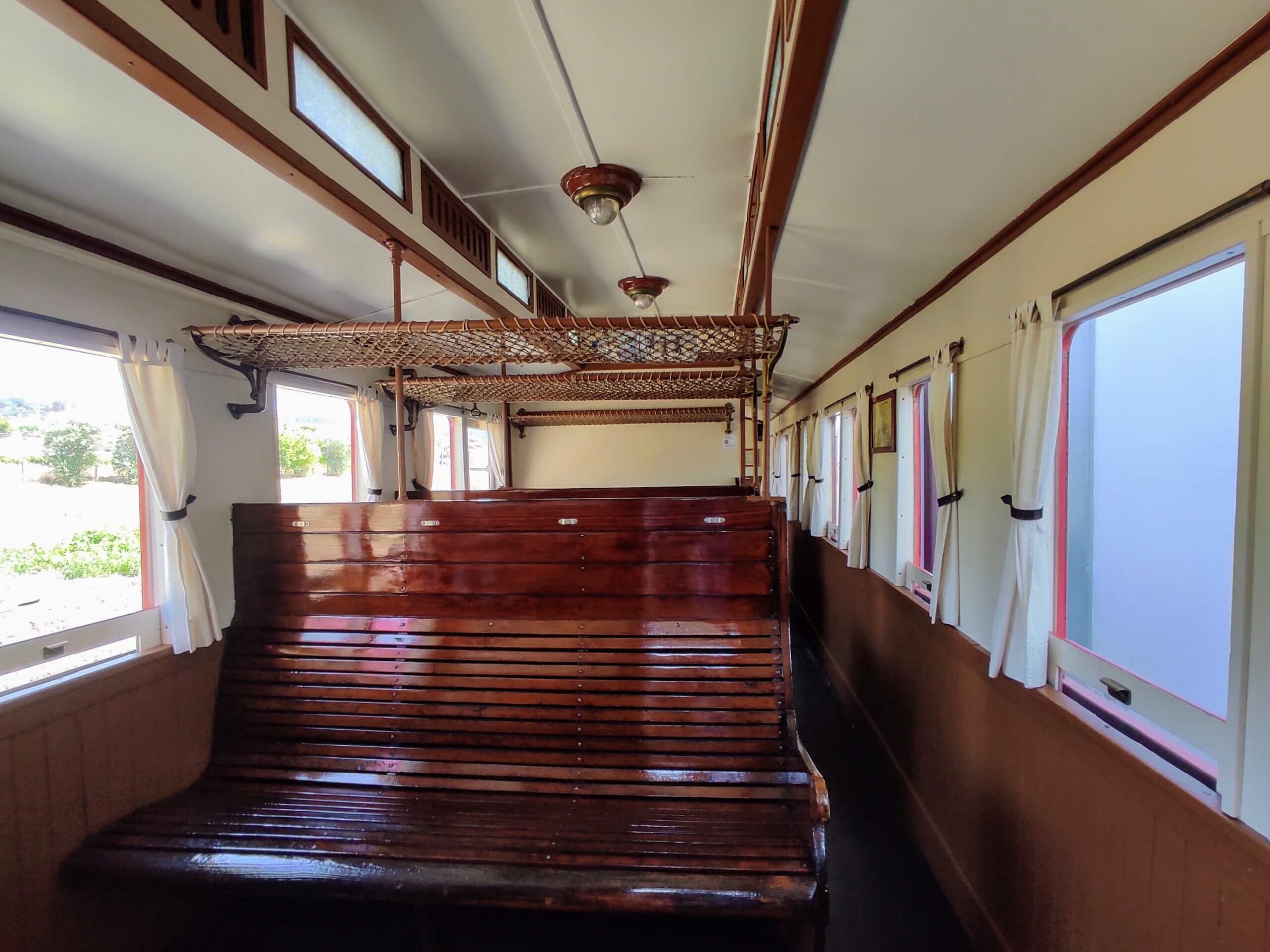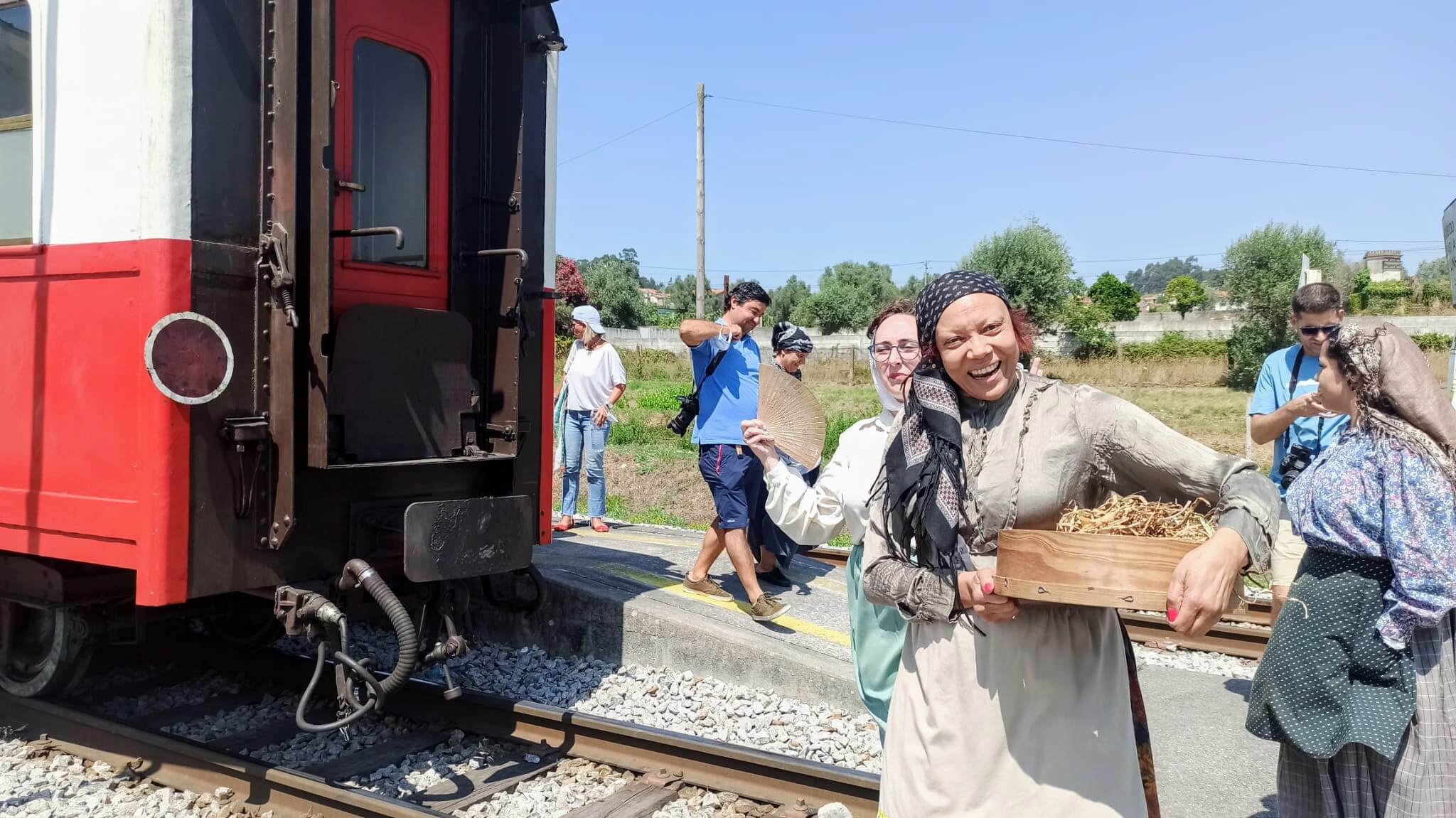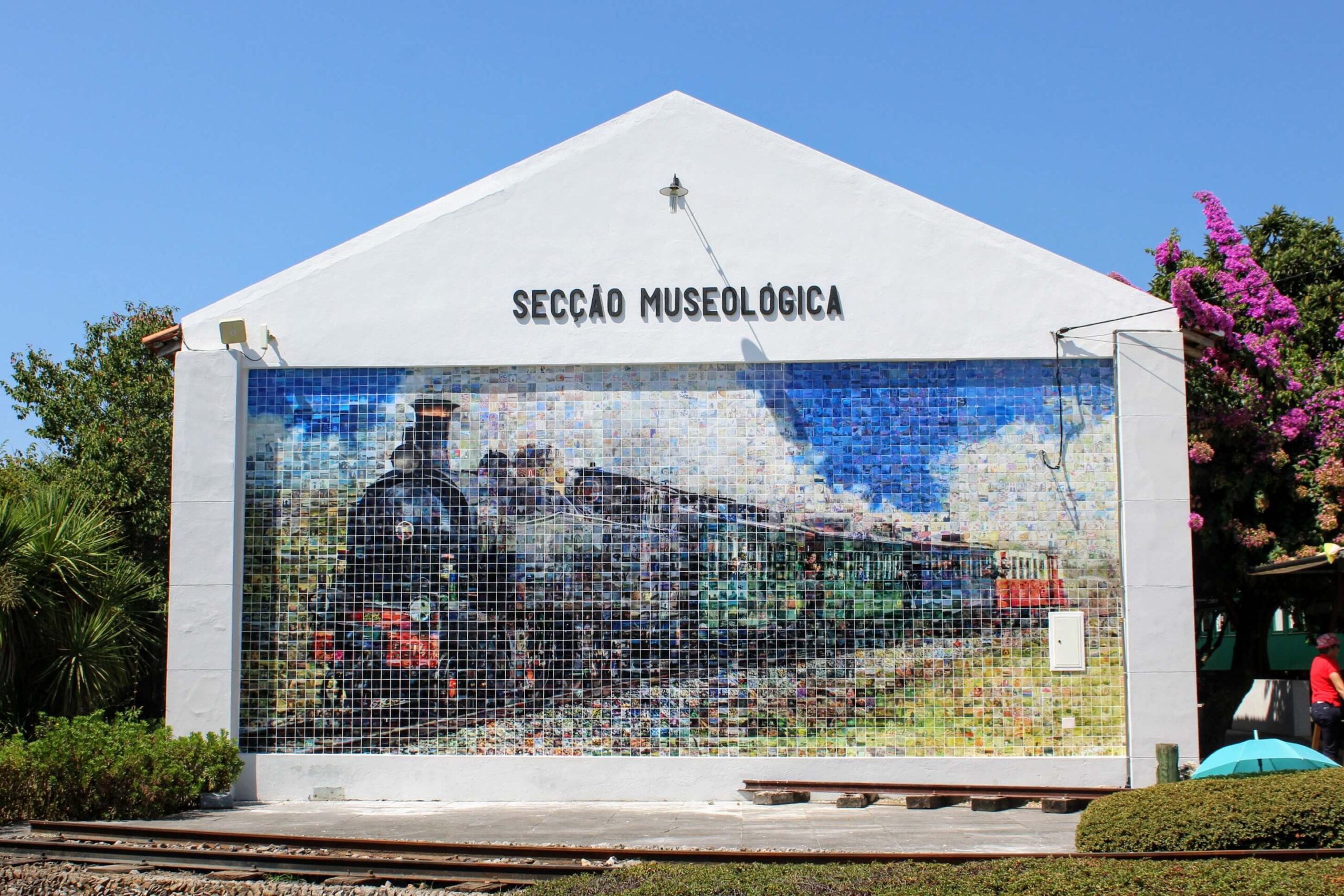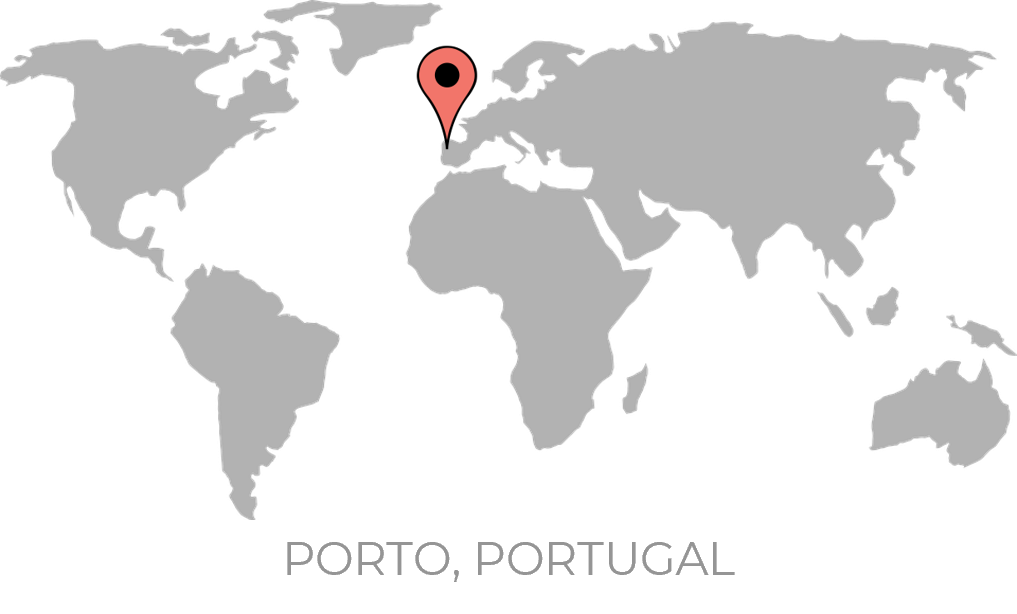

Portugal
Vouga Historical Train
João is passionate about trains – he knows all the carriages and gauges and has on his wish list of trips around the world to explore railway lines.
This summer we decided to start with a short trip near home – the Vouga Historical Train – one of the only two remaining historical trains in Portugal.
Also known as Vouguinha, the train runs between Aveiro and Macinhata do Vouga, on Saturdays, between June and October. With 5 carriages from the early years of the 20th century towed by a diesel locomotive, the train uses the only narrow track line in operation in Portugal, with only 1 meter between tracks. The trip costs €35/person (round trip) and includes admission to the Macinhata do Vouga Railway Museum and 1 stop in Águeda to enjoy the “AgitÁgueda” and the “Umbrella Sky” project, on the dates scheduled for each event.
The train journey lasts 1 hour and 10 minutes between Aveiro station and Macinhata do Vouga, but count on a whole afternoon of sightseeing:
Aveiro » Macinhata do Vouga
Macinhata do Vouga » Aveiro
Sweet Dreams
The trip from Porto to Aveiro is a short one, so we chose not to stay overnight in Aveiro. There are several connections by train to Aveiro during the morning, so we recommend that you fully embrace this adventure and plan for your whole journey to be done by train. Check train schedules at your starting point.
If you come from afar, or want to enjoy dinner and visit Aveiro, know that upon presentation of a ticket of the Vouga Historical Train, you will receive 15% discount on the best rate of the day at Meliã Ria Aveiro Hotel &Spa.
IN MY SUITCASE I BRING…
Eastern Portugal can be quite hot in summer, and the train has no air conditioning. We recommend that you bring a hat, light clothing, water, fruit and some snacks. The shoes must be comfortable to be able to get in and out of the carriages with ease and walk through the streets of Águeda in your free time.
Walk the Talk
We arrived in Aveiro around noon to spend the morning enjoying the busy canal area full of tourists marveled by the “Portuguese Venice” and young parents, relieved to have space for their children to run at ease.
We started at the former Jerónimo Pereira Campos factory, a beautiful brick building, now reconstructed and transformed into a Congress Center. We walked along the canal towards the Aveiro Forum, an outdoor mall where you can find most street fashion brands.
The bridges over the canals are very popular to take photographs and wave to the “Moliceiros” boats, originally used to harvest “moliço”, a type of algae used as agricultural fertilizer. Nowadays, these boats are loaded with excited tourists. Take a look at the bridge “Laços da Amizade” (ties of friendship) to which people tie colorful ribbons asking for a wish or honoring a special moment or person.
We entered the Manuel Firmino Market, which still sells flowers, fruits and vegetables but that was oddly empty for a Saturday morning. Pretty much all the market stores facing the outside are occupied by restaurants, with the exception of a crockery store from the popular Portuguese brand “Costa Nova”. Searching for a place to have dessert, we walked along Avenida Dr. Lourenço Peixinho, to the train station, stopping for coffee at Tricana de Aveiro. Opened in 1927, this confectionery and guest house is set in a building and historic site of the city with charming architecture. Be sure to try the traditional egg cream boats.
Around 13:40, we entered the train station on to line 8, from where our train departed – the energy on the platform was vibrant, with the carriages full of train fans and enthusiastic travelers, mostly national. Men and women dressed in traditional costumes waved goodby to the passengers from the platform, with their straw baskets loaded with local products.
The train departures at 13.50 sharp and proceeds first through the city outskirts, then onto the countryside. The generous, cheerful nod of the people the train passes through, transports us to old times, in which the passage of the train carried hopes and dreams, news and opportunities. At first, those on the train, heads peeping out through the window, begin by saying goodbye with caution and embarrassment, fearing this proximity so uncommon these days. But it doesn’t take many kilometers to realize that this line brings together those who live in more remote areas and those who pass through there – and that this brings a forgotten comfort to everyone.
Upon arrival in Macinhata do Vouga, we are greeted by a folk group singing “Apita o Comboio” , a popular song about a train, and other traditional songs. People leave the train eager to stretch their legs but are quickly rammed by the characters who gather on the platform – the rich lady who complains about the heat, the maid who watches her, the lady who brings a corn basket on her head, among others. Macinhata do Vouga Theatre Group joins the Railway Museum to give color to this historical recreation, which continues inside the museum, where the tour is guided by the station chief.
It should be noted that the entrance to the museum is done in groups, so you may have to wait your turn in line, most likely in the sun. A few stalls outside the Museum offer distraction for some time, selling water, beer and snacks such as “rissóis” (fried savory pastry) or “pataniscas” (cod cakes). We recommend avoiding the initial crowd on the stalls and instead take those initial moments when the train stops to check all the carriages, inside and out, as they are different from each other. It is also a great opportunity to take good pictures. Join the back of the line to the museum when only 1 or 2 groups are missing.
The visit to the Museum begins with a short performance by the Macinhata do Vouga Theatre Group, which is in the station’s waiting room to buy tickets. Stools, watches, petards, royal tickets, and other relics make the scene very close to what it has been once. In the second part of the museum, there are several carriages and locomotives, preserved over the years – some of the oldest date from World War I, and were offered by Germany as a reward after having lost the war. Among the carriages, the “Postal Ambulance” and the two self-propelled gasoline locomotives, transformed from buses, stand out the most.
After about an hour and a half in Macinhata, the return journey begins, divided into two stages:
In the first part of the return trip, representatives of the Municipality walk through the carriages to inform that, upon arrival in Águeda, they will accompany those who wish to go to the city center, passing through some works of urban art. The stop in Águeda lasts for an hour and a half, with the city center being a 10-minute walk from the train station – on your way, admire “Salamander” an art work from Bordalo II (R. Dr. Adolfo Portela 73, 3750-119 Águeda) and the installation “ANA 00:00,02” by Dourone.
When you reach the center of Águeda, there is plenty of time to walk through the famous streets covered with colorful umbrellas. Most of those who come on the train stop at the beginning of Rua Luis de Camões, to cool off in the ice cream shop “Rei del Gelato”; to avoid queuing and make the most of our time there, we walked to the Tourist Office of Águeda, in Largo Dr. Elísio Sucena, passing through Praça da República and up the Vasco da Gama Street, until we crossed the Rua José Maria Veloso where we returned to the starting point.
Stop for a beer with lupin beans on the terrace of cafe “20 Age”. If you are not a fan, you can also go for “Gelados de Portugal”, ice creams from a Portuguese brand who promotes traditional flavors and uses local ingredients in its production. Service at “20 Age” is very friendly so ask for help if you can’t choose between flavors.
The train left Águeda at 18:18 sharp, arriving in Aveiro at 19:00.
In my suitcase I brought
Macinhata do Vouga and its train museum had few but interesting souvenirs – we brought 1 handmade magnet with a wooden locomotive, an old train ticket and the book “Back to the Past”, an historical portrait of the Vouga Line, in a special edition by THEME – Spontaneous Theatre Group of Macinhata.
Shopping in Águeda though, was disappointing – with tourists not even being given a map, they were left wandering through streets of closed shops. There are a couple of souvenir shops selling umbrella magnets, and other allusive items, but nothing worth noting.
Overall, we felt that the town was barely taking advantage of the opportunity to do business with the many tourists that come with the train, eager to eat, drink and shop. Sharing a town map, with a directory of urban art, local attractions, shops, restaurants etc, could be helpful for both local economy and tourists.
In my suitcase I brought
Macinhata do Vouga and its train museum had few but interesting souvenirs – we brought 1 handmade magnet with a wooden locomotive, an old train ticket and the book “Back to the Past”, an historical portrait of the Vouga Line, in a special edition by THEME – Spontaneous Theatre Group of Macinhata.
Shopping in Águeda though, was disappointing – with tourists not even being given a map, they were left wandering through streets of closed shops. There are a couple of souvenir shops selling umbrella magnets, and other allusive items, but nothing worth noting.
Overall, we felt that the town was barely taking advantage of the opportunity to do business with the many tourists that come with the train, eager to eat, drink and shop. Sharing a town map, with a directory of urban art, local attractions, shops, restaurants etc, could be helpful for both local economy and tourists.
Conclusion
Our train journey was a busy, cheerful day, which we recommend to all train fans around the world. It is a great family program too, which we are sure kids will love and remeber.
As João said with satisfaction at the end of the day “Trains are here to stay” !
Francisca Peixoto
Francisca is a vibrant and cheerful travel enthusiast, who combines her natural talent for planning with a meticulous attention to detail, leaving no aspect of our travels to chance. Whether she’s meticulously crafting the perfect itinerary for our adventures into unexplored territories, uncovering hidden gems along the way, or on the hunt for the ultimate culinary experience, Francisca’s impeccable organization guarantees an unforgettable journey. When not traveling, she can be found hanging out with her loved ones, playing the role of the ultimate hostess. She loves bringing people together and knows how to throw a memorable dinner at our place. Let me tell you, she’s a busy bee, so I challenge you to try and book something on her already-packed agenda without giving her at least a week’s notice. Trust me, it won’t be an easy task!





































